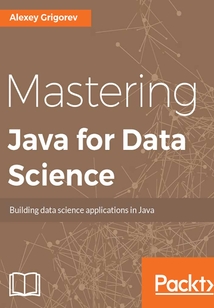舉報 

會員
Mastering Java for Data Science
最新章節:
Summary
ThisbookisintendedforsoftwareengineerswhoarecomfortablewithdevelopingJavaapplicationsandarefamiliarwiththebasicconceptsofdatascience.Additionally,itwillalsobeusefulfordatascientistswhodonotyetknowJavabutwantorneedtolearnit.Ifyouarewillingtobuildefficientdatascienceapplicationsandbringthemintheenterpriseenvironmentwithoutchangingtheexistingstack,thisbookisforyou!
目錄(179章)
倒序
- 封面
- 版權信息
- Credits
- About the Author
- About the Reviewers
- www.PacktPub.com
- Customer Feedback
- Preface
- What this book covers
- What you need for this book
- Who this book is for
- Conventions
- Reader feedback
- Customer support
- Downloading the example code
- Downloading the color images of this book
- Errata
- Piracy
- Questions
- Data Science Using Java
- Data science
- Machine learning
- Supervised learning
- Unsupervised learning
- Clustering
- Dimensionality reduction
- Natural Language Processing
- Data science process models
- CRISP-DM
- A running example
- Data science in Java
- Data science libraries
- Data processing libraries
- Math and stats libraries
- Machine learning and data mining libraries
- Text processing
- Summary
- Data Processing Toolbox
- Standard Java library
- Collections
- Input/Output
- Reading input data
- Writing ouput data
- Streaming API
- Extensions to the standard library
- Apache Commons
- Commons Lang
- Commons IO
- Commons Collections
- Other commons modules
- Google Guava
- AOL Cyclops React
- Accessing data
- Text data and CSV
- Web and HTML
- JSON
- Databases
- DataFrames
- Search engine - preparing data
- Summary
- Exploratory Data Analysis
- Exploratory data analysis in Java
- Search engine datasets
- Apache Commons Math
- Joinery
- Interactive Exploratory Data Analysis in Java
- JVM languages
- Interactive Java
- Joinery shell
- Summary
- Supervised Learning - Classification and Regression
- Classification
- Binary classification models
- Smile
- JSAT
- LIBSVM and LIBLINEAR
- Encog
- Evaluation
- Accuracy
- Precision recall and F1
- ROC and AU ROC (AUC)
- Result validation
- K-fold cross-validation
- Training validation and testing
- Case study - page prediction
- Regression
- Machine learning libraries for regression
- Smile
- JSAT
- Other libraries
- Evaluation
- MSE
- MAE
- Case study - hardware performance
- Summary
- Unsupervised Learning - Clustering and Dimensionality Reduction
- Dimensionality reduction
- Unsupervised dimensionality reduction
- Principal Component Analysis
- Truncated SVD
- Truncated SVD for categorical and sparse data
- Random projection
- Cluster analysis
- Hierarchical methods
- K-means
- Choosing K in K-Means
- DBSCAN
- Clustering for supervised learning
- Clusters as features
- Clustering as dimensionality reduction
- Supervised learning via clustering
- Evaluation
- Manual evaluation
- Supervised evaluation
- Unsupervised Evaluation
- Summary
- Working with Text - Natural Language Processing and Information Retrieval
- Natural Language Processing and information retrieval
- Vector Space Model - Bag of Words and TF-IDF
- Vector space model implementation
- Indexing and Apache Lucene
- Natural Language Processing tools
- Stanford CoreNLP
- Customizing Apache Lucene
- Machine learning for texts
- Unsupervised learning for texts
- Latent Semantic Analysis
- Text clustering
- Word embeddings
- Supervised learning for texts
- Text classification
- Learning to rank for information retrieval
- Reranking with Lucene
- Summary
- Extreme Gradient Boosting
- Gradient Boosting Machines and XGBoost
- Installing XGBoost
- XGBoost in practice
- XGBoost for classification
- Parameter tuning
- Text features
- Feature importance
- XGBoost for regression
- XGBoost for learning to rank
- Summary
- Deep Learning with DeepLearning4J
- Neural Networks and DeepLearning4J
- ND4J - N-dimensional arrays for Java
- Neural networks in DeepLearning4J
- Convolutional Neural Networks
- Deep learning for cats versus dogs
- Reading the data
- Creating the model
- Monitoring the performance
- Data augmentation
- Running DeepLearning4J on GPU
- Summary
- Scaling Data Science
- Apache Hadoop
- Hadoop MapReduce
- Common Crawl
- Apache Spark
- Link prediction
- Reading the DBLP graph
- Extracting features from the graph
- Node features
- Negative sampling
- Edge features
- Link Prediction with MLlib and XGBoost
- Link suggestion
- Summary
- Deploying Data Science Models
- Microservices
- Spring Boot
- Search engine service
- Online evaluation
- A/B testing
- Multi-armed bandits
- Summary 更新時間:2021-07-02 23:44:57
推薦閱讀
- Python數據挖掘:入門、進階與實用案例分析
- Access 2007數據庫應用上機指導與練習
- Mastering Machine Learning with R(Second Edition)
- 達夢數據庫性能優化
- 深入淺出Greenplum分布式數據庫:原理、架構和代碼分析
- 云原生數據中臺:架構、方法論與實踐
- Power BI智能數據分析與可視化從入門到精通
- Oracle數據庫管理、開發與實踐
- Visual FoxPro數據庫技術基礎
- 計算機視覺
- Access 2010數據庫程序設計實踐教程
- 云計算
- PostgreSQL高可用實戰
- 數據中臺實戰:手把手教你搭建數據中臺
- 區塊鏈應用開發指南:業務場景剖析與實戰
- 數據挖掘算法實踐與案例詳解
- MySQL應用實戰與性能調優
- Python數據可視化之matplotlib精進
- MySQL必知必會
- Access數據庫實用教程習題與實驗指導(第2版)
- Spark大數據商業實戰三部曲:內核解密、商業案例、性能調優(第2版)
- 一本書講透首席數據官:CDO知識體系與能力模型詳解
- 劍指大數據:Flink學習精要(Scala版)
- 數據庫原理與實踐(Access版)
- 大數據偵查
- Splunk實踐指南
- 數據可視化分析:Tableau原理與實踐(全彩)
- 數據架構之道:數據模型設計與管控
- Oracle DBA手記 3:數據庫性能優化與內部原理解析
- 軌跡數據分析方法及應用

